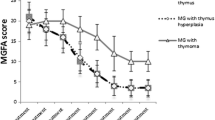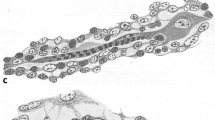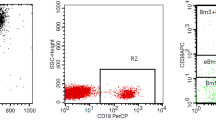Summary
The microenvironment of myoid cells (MyCs) was studied in myasthenia gravis (MG) thymitis with lymphoid follicular hyperplasia (LFH) (nine cases) and with diffuse B cell infiltration (one case), and compared with findings in the thymuses of non-myasthenic control subjects (ten cases). Double immunostaining was used to demonstrate MyCs labelled by anti-desmin together with other thymic components such as keratin-positive epithelial cells, Ki-M 1-positive interdigitating reticulum cells (IDCs), Ki-M 4-positive follicular dendritic reticulum cells, Ki-M 6-positive macrophages, CD22-positive B-cells, CD1-positive cells, CD3-positive T-cells or HLA-DR-positive cells. Round or elongated MyCs were confined to the thymic medulla and were surrounded by CD3-positive T-cells and CD22-positive B-cells. In MG thymitis MyCs were localized in the vicinity of, but not inside germinal centres (GCs). MyCs were always HLA-DR-negative, but were invariably embedded in a cellular micromilieu with strong HLA-DR expression. A remarkable feature of MG thymitis was that the great majority of MyCs were in intimate contact with intramedullary IDCs. Morphometric studies confirmed that such contacts were significantly less frequent in thymuses from non-myasthenic subjects. This indicates that an IDC-dependent antigen-presenting process for T-cells may actively involve MyCs in MG thymitis.
Similar content being viewed by others
References
Bargmann W (1943) Der Thymus. In: Möllendorf W (ed) Handbuch der mikroskopischen Anatomie des Menschen, vol. 6. Springer, Berlin Heidelberg, pp 1–172
Bearman RM, Levine GD, Bensch KG (1978) The ultrastructure of the normal human thymus. A study of 36 cases. Anat Res 190:755–782
Bofill M, Janossy G, Willcox N, Chilosi M, Trejdosiewicz K, Newsom-Davis J (1985) Microenvironments in the normal thymus and the thymus in myasthenia gravis. Am J Pathol 119:462–473
Dardenne M, Savino W, Bach JF (1987) Thymomatous epithelial cells and skeletal muscle share a common epitope defined by a monoclonal antibody. Am J Pathol 126:194–198
Drenckhahn D, von Gaudecker B, Müller-Hermelink HK, Unsicker K, Gröschel-Stewart U (1979) Myosin and actin containing cells in the human postnatal thymus. Ultrastructural and immunohistochemical findings in normal thymus and in myasthenia gravis. Virchows Arch [Cell Pathol] 32:33–45
Eimoto T, Teshima K, Shirakusa T, Takeshita M, Okamura H, Naito H, Mitsui T, Kikuchi M (1986) Heterogeneity of epithelial cells and reactive components in thymomas. An ultrastructural and immunohistochemical study. Ultrastruct Pathol 10:157–173
Engel WK, Trotter ML, McFarlin DE, Mclntosh CL (1977) Thymic epithelial cell contains acetylcholine receptor. Lancet 1:1310–1311
Feller AC, Parwaresch MR (1983) Simultaneous enzyme-histochemical detection of antigens in monocellular specimens with monoclonal antibodies. J Immunol Methods 63:273–279
Feltkamp-Vroom T (1966) Myoid cells in human thymus. Lancet 1:1320–1321
Foulis AK (1986) Class II major histocompatibility complex and organ specific autoimmunity in man. J Pathol 150:5–11
Gerdes J, Schwarting R, Stein H (1986) High proliferative activity of Reed Sternberg associated antigen Ki-1 positive cells in normal lymphoid tissue. J Clin Pathol 39:993–997
Gilhus NE, Aarli JA, Christensson B, Matre RV (1984/85) Rabbit antiserum to citric acid extract of human skeletal muscle staining thymomas from myasthenia gravis patients. J Neuroimmunol 7:55–64
Gown AM, Vogel AM (1982) Monoclonal antibodies to intermediate filament proteins of human cells. Unique and crossreacting antibodies. J Cell Biol 95:414–424
Graham RC, Karnovsky MJ (1966) The early stages of absorption of injected horseradish peroxidase in the proximal tubules of the mouse kidney. Ultrastructural cytochemistry by a new technique. J Histochem Cytochem 14:219–302
Hayward AR (1972) Myoid cells in the human foetal thymus. J Pathol 106:45–48
Henry K (1966) Mucin secretion and striated muscle in the human thymus. Lancet 1:183–185
Ito T, Hoshino T, Abe K (1969) The fine structure of myoid cells in the human thymus. Arch Histol Jpn 30:207–215
Kaiserling E, Stein H, Müller-Hermelink HK (1974) Interdigitating cells in human thymus. Cell Tiss Res 155:47–55
Kao I, Drachman DB (1977) Thymus muscle cells bear acetylcholine receptors: Possible relation to myasthenia gravis. Science 195:74–75
Kaplow LS (1968) Leucocyte alkaline phosphatase cytochemistry: Applications and methods. Ann NY Acad Sci (USA) 155:911–947
Kirchner Th, Schalke B, Melms A, von Kügelgen T, Müller-Hermelink HK (1986) Immunohistological patterns of nonneoplastic changes in the thymus in myasthenia gravis. Virchows Arch [Cell Pathol] 52:237–257
Kirchner Th, Hoppe F, Müller-Hermelink HK, Schalke B, Tzartos S (1987a) Acetylcholine receptor epitopes on epithelial cells of thymoma in myasthenia gravis. Lancet 1:218
Kirchner Th, Tzartos S, Hoppe F, Schalke B, Wekerle H, Müller-Hermelink HK (1988b) Pathogenesis of myasthenia gravis: Acetylcholine receptor-related antigenic determinants in tumor-free thymuses and thymic epithelial tumors. Am J Pathol (in press)
Lojda Z, Gossrau R, Schiebler TH (1976) Enzymhistochemische Methoden. Springer, Berlin Heidelberg New York
Matsumoto Y, Furuya A, Kabayashi T, Hiroshi T (1986) Primary cultures of human myasthenia gravis thymus. Studies of cell morphology, cell proliferation pattern and localization of α-bungarotoxin binding sites on cultured thymic cells. JNeuro Sci 75:121–133
Mayer S (1988) Zur Lehre von der Schilddrüse und Thymus bei Amphibien. Ana Anz 3:97–103
Melms A, Endler B, Kirchner Th, Schalke BCG, Müller-Hermelink HK, Wekerle H (1987) The thymus in myasthenia gravis: Functional and morphological studies. Ann NY Acad Sci (USA) (in press)
Palestro G, Tridente G, Micca FB, Novero D, Valente G, Go-dio L (1983) Immunohistochemical and enzyme histochemical contributions to the problem concerning the role of the thymus in the pathogenesis of myasthenia gravis. Virchows Arch [Cell Pathol] 44:172–186
Parwaresch MR, Radzun HJ, Hansmann M-L, Peters K-P (1983) Monoclonal antibody Ki-M 4 specifically recognizes human dendritic reticulum cells (follicular dendritic cells) and their possible precursors in blood. Blood 62:585–590
Parwaresch MR, Radzun HJ, Kreipe H, Hansmann M-L, Barth J (1986) Monocyte/macrophage-reactive monoclonal antibody Ki-M 6 recognizes an intracytoplasmic antigen. Am J Pathol 124:141–151
Radzun H-J, Parwaresch MR, Feller AC, Hansmann M-L (1984) Monocyte/macrophage specific monoclonal antibody Ki-M 1 recognizes interdigitating reticulum cells. Am J Pathol 117:441–450
Rosai J, Levine GD (1976) Tumors of the thymus. In: Atlas of tumor pathology. Sec Ser, Fasc 13. Armed Forces Institute of Pathology, Washington DC
Schluep M, Willcox N, Vincent A, Dhoot GK, Newsom-Davis J (1987) Acetylcholine receptors in human thymic myoid cells in situ: An immunohistochemical study. Ann Neurol 22:212–222
Steinmann G, Dardenne M, Gerdes J, Müller-Hermelink HK (1985) Autoimmunreaktionen im normalen menschlichen Thymus. Verh Dtsch Ges Pathol 69:578
Strauss AJL, Kemp PG, Douglas SD (1966) Myasthenia gravis. Lancet 1:772–773
Unanue ER, Beller DI, Lu CY, Allen PM (1984) Antigen presentation: Comments on its regulation and mechanism. J Immunol 132:1–5
Van der Geld HWR, Strauss AJL (1966) Myasthenia gravis: Immunological relationship between striated muscle and thymus. Lancet I:57–60
Van der Geld HWR, Feltkamp TEW, Osterhuis HJG (1964) Reactivity of myasthenia gravis serum γ-globulin with skeletal muscle and thymus demonstrated by immunofluorescence. Proc Soc Exp Biol Med 115:782–785
Van de Velde RKL, Friedman NB (1966) The thymic “Myoidzellen” and myasthenia gravis. JAMA 198:287–288
Van de Velde RL, Friedman NB (1970) Thymic myoid cells and myasthenia gravis. Am J Pathol 59:347–367
Vetters JM (1966) Myasthenia gravis. Lancet I:314
Vincent A, Wood H (1986) Antigenic specificity of monoclonal antibodies against Torpedo and human acetylcholine receptor, and use of these antibodies to investigate myasthenia gravis. In: Maelicke A (ed) Nicotinic acetylcholine receptor. Structure and function. NATO ASI Series, vol H 3. Springer, Berlin Heidelberg New York Tokyo, pp 93–102
Wekerle H, Ketelsen U-P, Zurn AD, Fulpius BW (1978) Intrathymic pathogenesis of myasthenia gravis: Transient expression of acetylcholine receptors on thymus derived myogenic cells. Eur J Immunol 8:579–581
Wekerle H, Hohlfeld R, Ketelsen U-OP, Kalden J, Kalies I (1981) Thymic myogenesis, T lymphocytes, and the pathogenesis of myasthenia gravis. Ann NY Acad Sci (USA) 377:455–476
Whiting P, Vincent A, Newsom-Davis J (1986) Myasthenia gravis: Monoclonal anti-human acetylcholine receptor antibodies used to analyse antibody specificities and responses to treatment. Neurology 36:612–617
Wiersbowsky-Schmeel A, Helpap B, Totovic V, Grouls V (1984) Thymus in myasthenia gravis: A light- and electronmicroscopic study of a case with thymic follicular hyperplasia. Pathol Res Pract 178:323–331
Willcox HNA, Newsom-Davis J, Calder LR (1983) Greatly increased autoantibody production in myasthenia gravis by thymocyte suspensions prepared with proteolytic enzymes. Clin Exp Immunol 54:378–386
Author information
Authors and Affiliations
Additional information
Dedicated to Professor V. Becker, Erlangen, on the occasion of his 65th birthday
Rights and permissions
About this article
Cite this article
Kirchner, T., Hoppe, F., Schalke, B. et al. Microenvironment of thymic myoid cells in myasthenia gravis. Virchows Archiv B Cell Pathol 54, 295–302 (1987). https://doi.org/10.1007/BF02899226
Received:
Accepted:
Issue Date:
DOI: https://doi.org/10.1007/BF02899226




